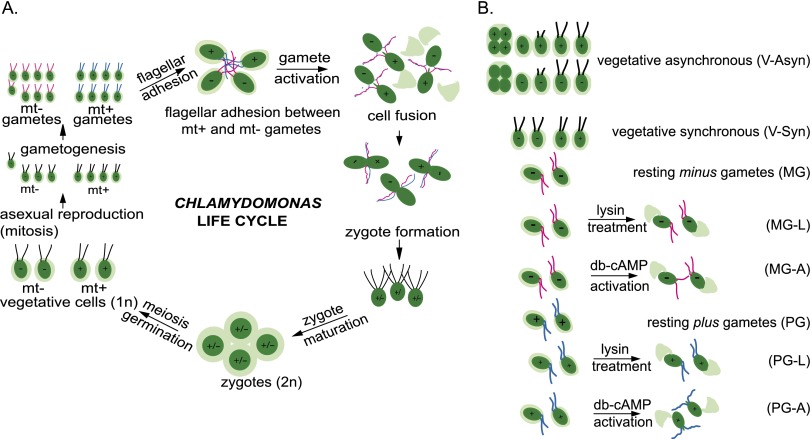Figure 1.
Life cycle of Chlamydomonas and description of treatment groups. (A) Gametes are formed when vegetative plus and minus cells undergo gametogenesis induced by nitrogen deprivation. When gametes of opposite mating type are mixed, they adhere to each other by adhesion molecules on their flagella—SAG1 on plus gametes and SAD1 on minus gametes. Flagellar adhesion induces gamete activation and an increase in cAMP that leads to release of cell walls, erection of mating structures at the apical ends of the gamete cell bodies (shown at top right), and several other cellular and biochemical changes that prepare the gametes for cell fusion. All of the events associated with gamete activation can be induced in gametes of a single mating type by incubating them in dibutyryl cAMP. The mating structure adhesion molecule FUS1 on the plus gamete binds to an unidentified receptor on the minus mating structure, and the membranes of the two structures fuse through the action of the minus gamete-specific fusion protein HAP2. Upon coalescence into a quadriflagellated zygote, the plus gamete-specific homeodomain protein GSP1 interacts with the minus gamete-specific homeodomain protein GSM1 to form a complex essential for activation of the zygote developmental pathway. Within several hours, the plus and minus nuclei congress and undergo fusion to form the diploid zygote nucleus. Upon return to the light after an obligatory period (at least 5 d) in the dark, the zygote undergoes DNA replication and meiosis, and the resulting four haploid progeny are released (germination) from the remnant of the mother cell wall and enter the vegetative part of their life cycle (Snell and Goodenough 2009). (B) The following eight samples were analyzed by RNA-seq: asynchronously growing vegetative cells (V-asyn), synchronously growing vegetative cells (V-syn), resting mating type minus gametes (MG), lysin-treated minus gametes (MG-L), dibutyryl cAMP-activated minus gametes (MG-A), resting mating type plus gametes (PG), lysin-treated plus gametes (PG-L), and dibutyryl cAMP-activated plus gametes (PG-A).

